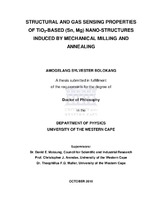Structural and gas sensing properties of TiO₂-based (Sn, Mg) nano-structures induced by mechanical milling and annealing
Abstract
Titanium oxynitride has attracted research interest for the fact that it is a bioactive
non-toxic material. It is suitable for surface coating of biomaterials and in other
applications such as anti-reflective coatings, while oxygen-rich titanium oxynitride
has been applied in thin film resistors and photocatalysis. Two common types of
titanium oxynitrides are TiOₓNᵧ. and TiO₂-ₓNᵧ. In this work, titanium mixed metals
oxynitrides (Ti-TiO₂, Mg-TiO₂ and Mg-Sn-TiO₂) were synthesized for the first time
using ball milling (BM) and annealing processes. Their structural, morphological,
surface, optical, and gas sensing properties were studied in detail. Structural
analyses showed that upon milling a pure TiO₂ phase, tetragonal to orthorhombic
phase transformation occurred. However, when milling TiO₂ mixed with Mg, Sn
and Ti no evidence of the transformation was observed. Furthermore, scanning
electron microscopy, transmission electron microscopy and atomic force
microscopy showed that the milling process promotes particle refinement. The
gas sensing analyses also demonstrated that the sensing response of the TiO₂,
Mg-TiO₂ and Mg-Sn-TiO₂ materials improved upon milling. Moreover, the Mg-TiO₂ showed improved sensing compared to pure TiO₂ due to incorporation of Mg, which might have resulted in a decrease of charge carrier concentration. The Mg-TiO₂ sensing materials showed fast response-recovery time of ~32 s and ~48 s, respectively, as well as high selectivity to NH₃ gas compared to other gases (H₂, and CH₄). In addition, the improved response observed for the milled samples is due to increased surface area and pore diameter, providing more active sites for the target gas and allowing more gas adsorption with an increase in point defects related to oxygen vacancies (Vo), which are the most favorable adsorption sites for oxygen species and thus can enhance the possibility of interaction with gas molecules. A combination of photoluminescence, x-ray photoelectron spectroscopy, vibrating sample magnetometer and sensing analyses demonstrated that a direct relation exists between the magnetization, sensing and the relative occupancy of the Vo present on the surface of TiO₂ nanoparticles. Therefore, based on these finding we conclude that the milling process promotes particle refinement, resulting in an increased BET surface and partial breaking of Ti–O bonds on the TiO₂ surface layer, which results in the formation of oxygen vacancies in the TiO₂ lattice, therefore anticipating improved sensing response.

